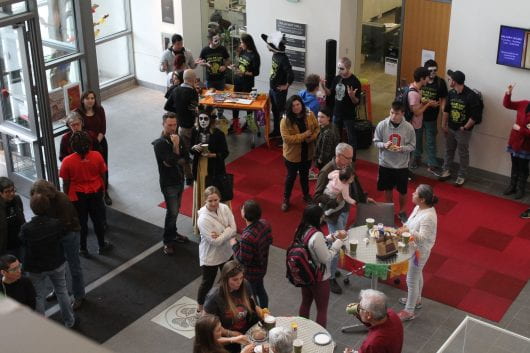
Students and Columbus community members gather in the Billy Ireland Cartoon Library to celebrate the Day of the Dead Oct. 19, 2019. Credit: Joseph Schmittgen | Lantern Reporter
Students and citizens of the greater Columbus community gathered on Ohio State’s campus to celebrate Dia de los Muertos — the Day of the Dead — a holiday that’s native Mesoamerican roots celebrate life through the spirit and memory of the dead.
The Day of the Dead celebration returned for its fourth year, and this year’s celebration included activities both at the Gateway Film Center and Sullivant Hall, where attendees were able to learn more about the holiday and celebrate. Activities included traditional face painting, dance performances, an exhibit in the Billy Ireland Cartoon Library on Latinx Comics and a traditional “Oferenda,” a decorative altar in honor of Robert Castilla Herrera — a local Latin American activist — as well as the victims of the shootings in Dayton, Ohio, and in El Paso, Texas, in August.
The event was hosted by the Department of Spanish and Portuguese in collaboration with University Libraries and sponsored by several Latinx groups and university organizations, according to the event’s website.
Pamela Espinosa de los Monteros, a librarian at Ohio State for Latin American studies and organizer of the exhibit, “Latinx Comicx Past, Present and Future,” said Dia de los Muertos is just one example of its kind.
“Every cultural tradition has a day to honor their dead,” Espinosa de los Monteros said. “For the Mesoamerican cultures —in particular Mexico and parts of Central America — they celebrate Dia de los Muertos.”
She said Dia de los Muertos serves as a day to honor your ancestors, people who have died, and during this special time, the dead can come back and be with those still on Earth.
“You rejoice, you are excited to see them, you’re excited to see someone you loved and is no longer here,” Espinosa de los Monteros said. “So you prepare special altars where you put some of their favorite items, pictures of who they are and also share the bounties of that year’s harvest.”
The event began at Gateway, where attendees were invited to a free showing of the 2017 movie, “Coco,” and could receive traditional face paint, often resembling a skull.
“It’s [the skull face painting] a reflection that this is who we are underneath our skin, that we all are wearing our skeletons underneath and that we’re all going to be turning back to that,” Paloma Martinez-Cruz, an associate professor of Latinx cultural studies as well as in the Department of Spanish and Portuguese said. “So it’s a celebration of how pretty our bones are.”
After the film, attendees joined Laura Rodriguez, a Master of Fine Arts student in choreographic research, in a traditional procession from Gateway to the Billy Ireland Library plaza, which garnered the attention of those along the path across High Street. They arrived at the plaza just as the dance performance by the Dance Brazil Tour Group was ready to begin.
Martinez-Cruz said the roots of such a procession are derived from the Catholic Church of Mexico as well as the native culture, and processions like these are a huge aspect of the spiritual experience.
“To process with your congregation, to move as a unit, to move as a community, that is a very important manifestation of how we are together, how we experience life and death together,” she said.
The dance performances, led by Crystal Perkins, a professor in the Department of Dance and director of the Dance Brazil Tour Group, said the group’s performance was inspired by African American-style dance in conjunction with its closely related West African-style movements.
The performance engaged the diverse crowd, and dancers invited members of the audience to join them on the plaza for a brief dance lesson. The movements featured rhythmic hip shaking, arm flailing and feet hopping to African-style drumming beats.
Martinez-Cruz said the incorporation of the dance Brazil group in collaboration with the Migration, Mobility and Immobility Project of the Global Arts and Humanities Discovery Themes further played into the theme of movement and how many cultures use movement to express themselves.
The following reception in Sullivant Hall featured the decorative altar, games and Pan de los Muertos, bread of the dead, a special bread that is only baked once a year for the Day of the Dead.
Visitors were able to visit Espinosa de los Monteros’ exhibit, “Latinx Comics Past Present and Future,” which features a collection of broadsides — large sheets of paper printed only on one side, historically used to announce events or simply for advertisements — by Jose Guadalupe Posada, whose work influences appear in the modern-day skeletal designs.
“So we actually have some of the original broadsides here now in our collection,” Espinosa de los Monteros said. “And we’ve expanded that to show the influence Posada has had on contemporary Latinx comics.”
She said many of the comics focus on the theme of global migration, immigration and mobility.
Pedro Antonio Ortiz-Ramirez, a doctoral candidate in the Department of Spanish and Portuguese, is a native of Mexico City, Mexico, and said he was surprised to see how Day of the Dead was celebrated at Ohio State.
“I find it interesting how you can understand Mexican culture from abroad,” Ortiz-Ramirez said. “I find it beautiful.”


